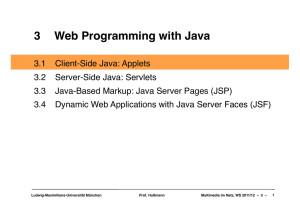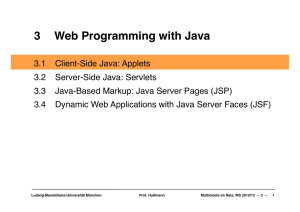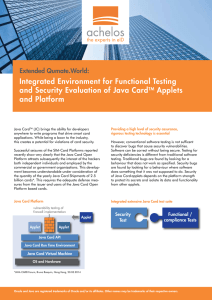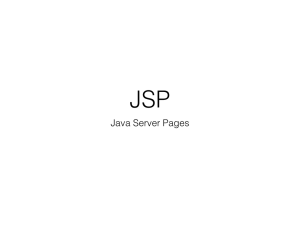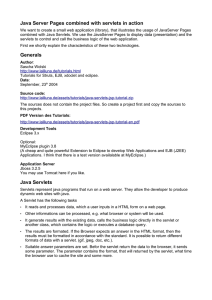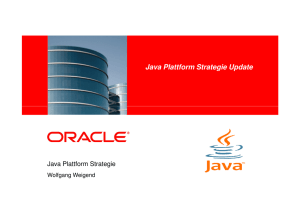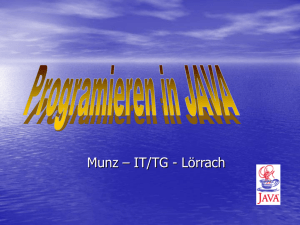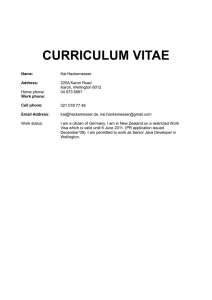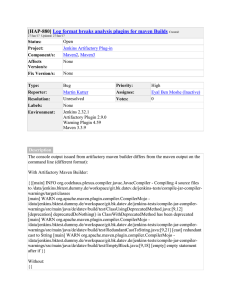html
Werbung
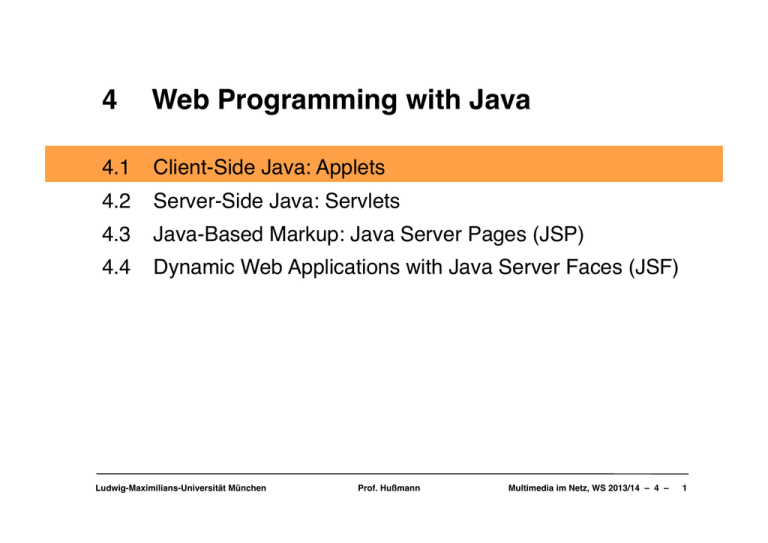
4 ! Web Programming with Java
4.1! Client-Side Java: Applets
4.2! Server-Side Java: Servlets
4.3! Java-Based Markup: Java Server Pages (JSP)
4.4! Dynamic Web Applications with Java Server Faces (JSF)
Ludwig-Maximilians-Universität München!
Prof. Hußmann!
Multimedia im Netz, WS 2013/14 – 4 –
1
Server-Side vs. Client-Side Realisation
Request
Browser Request
WebResponse Server
WebServer
Browser Response
Script
• Client-side realisation:
• Server-side realisation:
– Browser contains execution
engine for scripts
– Web server does not need to
execute scripts
– Script is sent to client as part
of server response
– Examples: JavaScript,
Java Applets
Ludwig-Maximilians-Universität München!
– Web server contains execution
engine for scripts
– Browser does not need to
execute scripts
– Script is executed on server and
computes response to client
– Examples: PHP,
Java Servlets,
Java Server Pages,
Java Server Faces
Prof. Hußmann!
Multimedia im Netz, WS 2013/14 – 4 –
2
Applets
• Applet:
– “application snippet”
– Java program, embedded in HTML page
– Executed by browser software
» directly or via plugin
– Does not contain a "main()" method!
• Application:
– Stand-alone Java program
– Contains a static "main()" method
Ludwig-Maximilians-Universität München!
Prof. Hußmann!
Multimedia im Netz, WS 2013/14 – 4 –
3
Example: Hello-World Applet (1)
import java.applet.Applet;
import java.awt.Graphics;
public class HelloWorldApplet extends Applet {
public void paint(Graphics g) {
g.setFont(new Font("SansSerif", Font.PLAIN, 48));
g.drawString("Hello world!", 50, 50);
}
}
• Class for applet derived from Applet
• Applet derived from Component
– Calls paint method
– Redefining the paint method means
it is executed at display time
• Similar to Java Swing, Java 2D
Ludwig-Maximilians-Universität München!
Prof. Hußmann!
Multimedia im Netz, WS 2013/14 – 4 –
4
Example: Hello-World Applet (2) – Old HTML
<html>
<head>
<title> Hello World </title>
</head>
<body>
The Hello-World example applet is called: <br>
<applet code="HelloWorldApplet.class" width=300>
</applet>
</body>
</html>
java/Applets/HelloWorld.html
Ludwig-Maximilians-Universität München!
This is frequently used but deprecated
HTML syntax!
Prof. Hußmann!
Multimedia im Netz, WS 2013/14 – 4 –
5
Example: Hello-World Applet (2) – New HTML
<html>
<head>
<title> Hello World </title>
</head>
<body>
The Hello-World example applet is called: <br>
<object type="application/x-java-applet"
height="100" width="400">
<param name="code" value="HelloWorldApplet" />
</object>
</body>
</html>
Modern HTML5 syntax
(Note : "classid" not supported in HTML5!)
Assuming "HelloWorldApplet.class" exists
java/Applets/HelloWorldNew.html
Ludwig-Maximilians-Universität München!
Prof. Hußmann!
Multimedia im Netz, WS 2013/14 – 4 –
6
Parameter Passing in HTML
Applet:
public class HelloWorldAppletParam extends Applet {
}
public void paint(Graphics g) {
String it = getParameter("insertedtext");
g.setFont(new Font("SansSerif", Font.PLAIN, 48));
g.drawString("Hello "+it+" world!", 50, 50);
}
This is modern HTML5.
HTML:
<html>
...
<br>
<object type="application/x-java-applet"
height="100" width="800">
<param name="code" value="HelloWorldAppletParam" />
<param name="insertedtext" value="wonderful" />
Java Applets not supported.
</object>
...
Java/Applets/HelloWorldParamNew.html
</html>
Ludwig-Maximilians-Universität München!
Prof. Hußmann!
Multimedia im Netz, WS 2013/14 – 4 –
7
Applet Life Cycle
init()
loaded
start()
running
stop()
stopped
destroy()
destroyed
Callback methods:
public class ... extends Applet {
. . .
public void init() { . . . }
public void start() { . . . }
public void stop() { . . . }
public void destroy() { . . . }
. . .
}
Ludwig-Maximilians-Universität München!
Prof. Hußmann!
Multimedia im Netz, WS 2013/14 – 4 –
8
User Interaction in Applets
• Applets are able to react to user input
– Define an event handler
– Register during applet initialization (init())
• Applets are executed locally, and therefore have full access to local input
– Mouse movements, key press, …
– This is not possible with server-side code!
• Applets can make use of graphics libraries
– For instance Java 2D
– This is not easily possible with server-side code!
Java/Applets/ClickMe.html
Ludwig-Maximilians-Universität München!
Prof. Hußmann!
Multimedia im Netz, WS 2013/14 – 4 –
9
Swing Applets
• Class javax.swing.JApplet
– Derived from Applet
– Is a top level Swing Container
• All Swing GUI components can be used
• Particularities of Swing Applets:
–
–
–
–
–
Add panels, layout managers etc as with JFrame
Default layout manager is BorderLayout
Direct drawing into a Swing applet is not recommended!
Redefine method paintComponent()
Call parent method:
public void paintComponent(Graphics g){
super.paintComponent(g);
. . .
}
Ludwig-Maximilians-Universität München!
Prof. Hußmann!
Multimedia im Netz, WS 2013/14 – 4 –
10
Example: Counter as Swing-Applet (1)
public class CounterSwingApplet extends JApplet {
CounterPanel counterPanel;
}
}
public void init() {
counterPanel = new CounterPanel();
add(counterPanel);
// The View
class CounterPanel
extends JPanel implements Observer {
private Counter ctr;
JPanel valuePanel = new JPanel();
JTextField valueDisplay = new JTextField(10);
JButton countButton = new JButton("Count");
JButton resetButton = new JButton("Reset");
JPanel buttonPanel = new JPanel();
. . .
Ludwig-Maximilians-Universität München!
Counter.html
Prof. Hußmann!
Multimedia im Netz, WS 2013/14 – 4 –
11
Example: Counter as Swing Applet (2)
public CounterPanel () {
class CounterPanel (contd.)
ctr = new Counter();
valuePanel.add(new Label("Counter value"));
. . .
add(valuePanel,BorderLayout.NORTH);
}
countButton.addActionListener(new ActionListener() {
public void actionPerformed (ActionEvent event) {
ctr.count();
}
});
. . .
ctr.addObserver(this);
public void update (Observable o, Object arg) {
valueDisplay.setText(String.valueOf(ctr.getValue()));
}
}
}
public void paintComponent(Graphics g){
super.paintComponent(g);
class Counter extends Observable { . . . }
Ludwig-Maximilians-Universität München!
Prof. Hußmann!
Multimedia im Netz, WS 2013/14 – 4 –
12
Organisation of Bytecode Files
• <object> and <applet> tags allow
– Declaration of a "codebase" directory (attribute codebase)
– Declaration of a Java archive (JAR) file (attribute archive)
• Advantages of codebase:
– Java bytecode concentrated at one location
– Fits with Java file conventions
• Advantages of archives:
– Less files, less HTTP connections, better performance
– Lower bandwidth requirements due to (LZW) compression
Cubic.html
Ludwig-Maximilians-Universität München!
Prof. Hußmann!
Multimedia im Netz, WS 2013/14 – 4 –
13
Applets and Security
• "Sandbox security":
An applet is not allowed to
–
–
–
–
–
Open network connections (except of the host from which it was loaded)
Start a program on the client
Read or write files locally on the client
Load libraries
Call "native" methods (e.g. developed in C)
• "Trusted" Applets
– Installed locally on the client, or
– Digitally signed and verified
– Such applets may get higher permissions, e.g. for reading/writing files
• Execution of applets from locally loaded files is restricted
– Recent addition
– Therefore, avoid local loading for tests!
Ludwig-Maximilians-Universität München!
Prof. Hußmann!
Multimedia im Netz, WS 2013/14 – 4 –
14
Advantages and Disadvantages of Java Applets
• Advantages:
–
–
–
–
Interaction
Graphics programming
No network load created during local interactions
Executed decentrally – good scalability
• Disadvantages:
– Dependencies on browser type, browser version, Java version
» Persisting problem, leading to many incompatibilities,
including recent Java 7 problems
– Debugging is problematic
– Java-related security problems (sandbox breaches)
siliconrepublic.com
Ludwig-Maximilians-Universität München!
Prof. Hußmann!
Multimedia im Netz, WS 2013/14 – 4 –
15
Typical Security Precautions
Ludwig-Maximilians-Universität München!
Prof. Hußmann!
Multimedia im Netz, WS 2013/14 – 4 –
16
Future of Client Plug-Ins?
• “Companies in general are migrating to pure HTML5 based applications
and moving away from plugins such as Flash, Silverlight and Java,”
Kandek said. “Java will continue to grow on the server side, where its
powerful processing capabilities are absolutely needed.”
Wolfgang Kandex, Qualys Inc. (Vulnerability Management Software)
Source:
http://www.pcworld.com/article/2030778/researchers-javas-security-problemsunlikely-to-be-resolved-soon.html
Ludwig-Maximilians-Universität München!
Prof. Hußmann!
Multimedia im Netz, WS 2013/14 – 4 –
17
4 ! Web Programming with Java
4.1! Client-Side Java: Applets
4.2! Server-Side Java: Servlets
4.3! Java-Based Markup: Java Server Pages (JSP)
4.4! Dynamic Web Applications with Java Server Faces (JSF)
Literature:
!
http://java.sun.com/products/servlet/docs.html
!
http://glassfish.java.net/
!
Ludwig-Maximilians-Universität München!
Prof. Hußmann!
Multimedia im Netz, WS 2013/14 – 4 –
18
Basic Principle: Server-Side Execution
1.
2.
3.
4.
5.
6.
User fills form
Form is sent as HTTP request to server
Server determines servlet program and executes it
Servlet computes response as HTML text
Response is sent to browser
Response, as generated by servlet, is displayed in browser
Ludwig-Maximilians-Universität München!
Prof. Hußmann!
Multimedia im Netz, WS 2013/14 – 4 –
19
Java-Enabled Web Server
• Servlets are part of Java Enterprise Edition (Java EE)
• Prerequisite:
– Web server must be enabled for Java servlets
» Recognize servlet requests
» Administer servlets
» Execute servlets (servlet container)
• Before doing any experiments:
– Install Servlet Container software
– E.g. Apache Tomcat or Oracle GlassFish
Ludwig-Maximilians-Universität München!
Prof. Hußmann!
Multimedia im Netz, WS 2013/14 – 4 –
20
Java Servlets
• Java Servlet Specification (JSS):
–
–
–
–
–
Part of Java Enterprise Edition (EE)
First version: 1996 (Java: 1995)
Current version: 3.0 (with Java EE 6)
Java Server Pages: 1997–1999
Java Server Faces: 2001 – … (Version 2.3: April 2013)
• Reference implementation for a “servlet container”:
– “GlassFish” (Oracle)
• Other well-known Java EE servers:
– Apache Tomcat (Catalina), BEA Weblogic (now Oracle), JBoss, jetty
• Basic principle very similar to PHP:
– Web server calls (Java) servlet code on request from client
– Servlet determines response to client
» Most obvious usage: Produces a HTML page
» Other usages: Acts as server-side partner in AJAX-like technologies
Ludwig-Maximilians-Universität München!
Prof. Hußmann!
Multimedia im Netz, WS 2013/14 – 4 –
21
Servlet-API: Basics
• abstract class javax.servlet.GenericServlet
– Declares method service()
• abstract class javax.servlet.http.HttpServlet
– Subclass of GenericServlet for HTTP servlets
– Defines standard implementation for method service(), calls
» doPost(), doGet(), doPut()
protected void doGet(HttpServletRequest req,
HttpServletResponse resp)
protected void doPost(HttpServletRequest req,
HttpServletResponse resp)
• interface javax.servlet.http.HttpServletRequest
– Provides information about request, method examples:
getAttribute(), getParameter(), getReader()
• interface javax.servlet.http.HttpServletResponse
– Access to response construction, method examples:
setContentType(), getWriter()
Ludwig-Maximilians-Universität München!
Prof. Hußmann!
Multimedia im Netz, WS 2013/14 – 4 –
22
Example: Hello-World Servlet
import java.io.*;
import javax.servlet.*;
import javax.servlet.http.*;
public class HelloWorld extends HttpServlet {
}
public void doGet(HttpServletRequest request,
HttpServletResponse response)
throws IOException, ServletException
{
response.setContentType("text/html");
PrintWriter out = response.getWriter();
out.println("<html>");
out.println("<head>");
out.println("<title>Hello World!</title>");
out.println("</head>");
out.println("<body>");
out.println("<h1>Hello World!</h1>");
out.println("</body>");
out.println("</html>");
}
Ludwig-Maximilians-Universität München!
Prof. Hußmann!
Multimedia im Netz, WS 2013/14 – 4 –
23
Example: Very Simple Dynamic Servlet
HTML page showing current date and time
public class myDate extends HttpServlet {
private static final long serialVersionUID = 11L;
public void doGet (HttpServletRequest request,
HttpServletResponse response)
throws ServletException, IOException {
String title = "Date Servlet Page";
response.setContentType("text/html");
PrintWriter out = response.getWriter();
out.println("<html><head><title>");
out.println(title);
out.println("</title></head><body>");
out.println("<h1>" + title + "</h1>");
out.print("<p>Current time is: ");
out.println(new java.util.GregorianCalendar().getTime());
out.println("</body></html>");
out.close();
}
}
Ludwig-Maximilians-Universität München!
http://localhost:8080/myDateServlet/
Prof. Hußmann!
Multimedia im Netz, WS 2013/14 – 4 –
24
Deployment of Servlet Application
• Servlet is a Java code file (myDate.java)
– Needs to be compiled (myDate.class)
– Needs to be made known to the Servlet Container
• Deployment:
– Installation of new server-side java code in the server software
– Provide a location (directory), called context path
– Provide metadata on the new application
• Usually a Dynamic Web application is archived (with jar) in a single
archive file with “.war” extension (Web application archive)
• Several ways for deployment exist
– E.g. administrative Web interface of GlassFish
– E.g. through development environments
» e.g. NetBeans, Eclipse (with GlassFish Plugin)
Ludwig-Maximilians-Universität München!
Prof. Hußmann!
Multimedia im Netz, WS 2013/14 – 4 –
25
<?xml version="1.0" encoding="ISO-8859-1"?>
<!DOCTYPE web-app
PUBLIC "-//Sun Microsystems, Inc.//DTD Web Application 2.3//EN"
"http://java.sun.com/dtd/web-app_2_3.dtd">
<web-app>
<display-name>My little Date Application</display-name>
<description>
Small demo example, by Heinrich Hussmann, LMU.
</description>
<context-param>
<param-name>webmaster</param-name>
<param-value>[email protected]</param-value>
<description>
The EMAIL address of the administrator.
</description>
</context-param>
<servlet>
<servlet-name>myDate</servlet-name>
<description>
Example servlet for lecture
</description>
<servlet-class>myDate</servlet-class>
</servlet>
<servlet-mapping>
<servlet-name>myDate</servlet-name>
<url-pattern>/</url-pattern>
</servlet-mapping>
<session-config>
<session-timeout>30</session-timeout>
<!-- 30 minutes -->
</session-config>
</web-app>
File Structure for Deployment
Meta information
Ludwig-Maximilians-Universität München!
Prof. Hußmann!
Multimedia im Netz, WS 2013/14 – 4 –
26
Administration Interface for Server
Ludwig-Maximilians-Universität München!
Prof. Hußmann!
Multimedia im Netz, WS 2013/14 – 4 –
27
4 ! Web Programming with Java
4.1! Client-Side Java: Applets
4.2! Server-Side Java: Servlets
4.3! Java-Based Markup: Java Server Pages (JSP)
4.4! Dynamic Web Applications with Java Server Faces (JSF)
Literature:
!
http://java.sun.com/products/jsp!
!
http://courses.coreservlets.com/Course-Materials/csajsp2.html
!
Ludwig-Maximilians-Universität München!
Prof. Hußmann!
Multimedia im Netz, WS 2013/14 – 4 –
28
Introductory Example: Java Server Page (JSP)
HTML page with current date/time
<html>
<%! String title = "Date JSP"; %>
<head><title> <%=title%> </title></head>
<body>
<h1> <%=title%> </h1>
<p>Current time is:
<% java.util.Date now = new GregorianCalendar().getTime(); %>
<%=now%></p>
</body></html>
• Basic idea for Java Server Pages:
– Scripts embedded in HTML
("Scriptlets")
– Automatic translation into
Java Servlet code
Java HTML
Ludwig-Maximilians-Universität München!
Prof. Hußmann!
Multimedia im Netz, WS 2013/14 – 4 –
29
Java Server Pages und Servlets
Translation to Servlet
on first request
(or pre-compiled installation)
Life of a JSP as sequence diagram:
Client
JSP-Server
xyz.jsp
xyz.jsp
install
compile
xyz-Servlet
start
res1
res1
res1: HTML
xyz.jsp
starten
res2
Ludwig-Maximilians-Universität München!
res2
Prof. Hußmann!
res2: HTML
Multimedia im Netz, WS 2013/14 – 4 –
30
JSP Language Elements
Note: JSP (current version: 2.2) is “deprecated”, to be superseded by JSF!
Java Server Pages specification provides markup language to be compiled
into Java Servlets
JSP can be used to generate arbitrary texts, not only HTML
Interesting target language: XML
Language elements:
• Script elements
Embedding of Java code
• Implicit objects
Access to important parts of servlets
• Directives
Global instructions for compilation
• Actions
Standard elements for runtime behavior
–
Ludwig-Maximilians-Universität München!
Prof. Hußmann!
Multimedia im Netz, WS 2013/14 – 4 –
31
Embedding of Scriptlets in HTML
Two options for embedding:
• JSP-specific syntax: Tags with special symbols
<%, <%!, <%=, <%@, %>, <%--, --%>
– Not elegant, but very practical
• XML-Syntax with name spaces
» XML name space (xmlns) prefix, e.g. "jsp"
» Prefix definition is bound to a URL
» Tags take the form <jsp: xyz>
» Used for JSP actions in particular
Ludwig-Maximilians-Universität München!
Prof. Hußmann!
Multimedia im Netz, WS 2013/14 – 4 –
32
JSP Script Elements
• Declarations
– Syntax:!<%! declarations %>
<jsp:declaration> declarations </jsp:declaration>
<%! String title = "Date JSP"; %>
– Example:!
– Is translated into instance variable of generated class,
i.e. visible in all methods of the class.
• Anweisungen (Scriptlets)
– Syntax:!<% commands %>
<jsp:scriptlet> commands </jsp:scriptlet>
<% java.util.Date now = new
– Example:!
GregorianCalendar().getTime(); %>
– Local variables are not visible in other methods.
• Expressions
<%= expression %>
<jsp:expression> expression </jsp:expression>
<%= now %>
– Example:!
– Equivalent to! <% out.print(now); %>
– Syntax:!!
Ludwig-Maximilians-Universität München!
Prof. Hußmann!
Multimedia im Netz, WS 2013/14 – 4 –
33
Implicit Objects in JSP Scripts
The most important implicit objects:
• request (javax.servlet.http.HttpServletRequest)
– To read HTTP headers, parameters, cookies etc. from request
• response (javax.servlet.http.HttpServletResponse)
– To write HTTP headers, cookies etc. into the response
• session (javax.servlet.http.HttpSession)
– Tracking of associated interactions ("sessions")
• out (javax.servlet.jsp.JspWriter)
– Output stream (result test)
– Standard print() and println() commands
• Example:
<% if (request.getParameter("CountButton")!=null) {
counter.count();
}; %>
Ludwig-Maximilians-Universität München!
Prof. Hußmann!
Multimedia im Netz, WS 2013/14 – 4 –
34
Generated Servlet Code (Excerpt)
<html>
<%! String title = "Date JSP"; %>
<head>
<title> <%=title%> </title>
</head>
<body>
<h1> <%=title%> </h1>
<p>Current time is:
<% java.util.Date now = new GregorianCalendar().getTime(); %>
<%=now%>
</body>
...
</html>
out.write("\r\n");
out.write("\t<body>\n");
out.write("\t\t<h1> ");
out.print(title);
out.write(" </h1>\n");
out.write("\t\t<p>Current time is:\n");
out.write("\t\t\t");
java.util.Date now = new GregorianCalendar().getTime();
out.write("\n");
out.write("\t\t\t");
out.print(now);
out.write("\n");
Ludwig-Maximilians-Universität München!
Prof. Hußmann!
Multimedia im Netz, WS 2013/14 – 4 –
35
Cleaning Up the JSP Code
• Mixture between Java scriptlets and HTML markup
– Is confusing
– Is difficult to maintain
• Approaches to a better structure of the JSP:
–
–
–
–
Use JavaBeans
Use Tag Libraries (Markup tags associated with Java implementation)
Use Standard Tag Library (JSTL)
Use Expression Language (JSP-EL)
!
(${…} and #{…})
– Use JSPX (XML syntax, easier to handle for editing tools)
• JSP has evolved into its own, rather complex, programming language
Ludwig-Maximilians-Universität München!
Prof. Hußmann!
Multimedia im Netz, WS 2013/14 – 4 –
36
What Is a JavaBean?
• JavaBeans is a software component model for Java
– Not to be confused with Enterprise Java Beans (EJBs)!
• Software components:
– Units of software which can be stored, transmitted, deployed, configured,
executed without knowing the internal implementation
– Main usage: Tools for composing components
• Driver for JavaBeans technology: User Interfaces
– AWT and Swing components are JavaBeans
– GUI editing tools instantiate and configure JavaBeans
• Main properties of a JavaBean:
– Has a simple constructor without parameters
– Provides public getter and setter methods for its properties:
getProp, setProp
(no setter = read-only)
– Is serializable
– Supports listener mechanism for property changes
» Bound properties: provide listener for changes
» Constrained properties: allow listeners to veto on changes
Ludwig-Maximilians-Universität München!
Prof. Hußmann!
Multimedia im Netz, WS 2013/14 – 4 –
37
JavaBeans in JSP: Action useBean
• Syntax of useBean Aktion:
<jsp:useBean id=localName class=className
scope=scopeDefn />
! scope:! "page“ (current page), "request" (current request);
!
"session" (current session), "application" (full application)
• Reading properties:
<jsp:getProperty
name=localName
property=propertyName/>
• Writing properties:
<jsp:setProperty
name=localName
property=propertyName/>
value=valueAsString
<jsp:getProperty name="counter" property="current"/>
!
is equivalent to:
<%=counter.getCurrent();%>
Ludwig-Maximilians-Universität München!
Prof. Hußmann!
Multimedia im Netz, WS 2013/14 – 4 –
38
Counter as JavaBean (1)
package counter;
public class CounterBean implements java.io.Serializable {
private static final long serialVersionUID = 12L;
private int count;
private int startValue;
private int incrValue;
private boolean enabled;
/** Creates new CounterBean */
public CounterBean() {
startValue = 0;
incrValue = 1;
reset();
enabled = true;
} ...
Ludwig-Maximilians-Universität München!
Prof. Hußmann!
Multimedia im Netz, WS 2013/14 – 4 –
39
Counter as JavaBean (2)
public void count () {
if (enabled) {
count += incrValue;
}
}
public void reset () {
count = startValue;
}
public int getCount() {
return count;
}
public void setCount(int count) {
this.count = count;
}
… (getters/setters for all local properties) …
}
Ludwig-Maximilians-Universität München!
Prof. Hußmann!
Multimedia im Netz, WS 2013/14 – 4 –
40
Counter JSP with JavaBeans: HTML Source
<%@ page contentType="text/html" session="true"%>
<html>
<head><title>Counter Demo Page</title></head>
<body>
<jsp:useBean id="counter" scope="session" class="counter.CounterBean"/>
<% if (request.getParameter("CountButton")!=null) {
counter.count();
};
if (request.getParameter("ResetButton")!=null) {
counter.reset();
}
%>
<h2>Counter Demo</h2>
<p>
Current counter value =
<jsp:getProperty name="counter" property="count" /></p>
<form method="POST" action="CounterJSP.jsp">
<input name="CountButton" type="submit" value="Count" />
<input name="ResetButton" type="submit" value="Reset" />
</form>
</body>
</html>
Ludwig-Maximilians-Universität München!
Prof. Hußmann!
Multimedia im Netz, WS 2013/14 – 4 –
41
4 ! Web Programming with Java
4.1! Client-Side Java: Applets
4.2! Server-Side Java: Servlets
4.3! Java-Based Markup: Java Server Pages (JSP)
4.4! Dynamic Web Applications with Java Server Faces (JSF)
Literature:
!
B. Müller: Java Server Faces 2.0, 2. Auflage, Hanser 2010
!
http://www.coreservlets.com/JSF-Tutorial/jsf2/!
!
Ludwig-Maximilians-Universität München!
Prof. Hußmann!
Multimedia im Netz, WS 2013/14 – 4 –
42
Java Server Faces (JSF)
• Java framework for building Web applications
– Latest version 2.2 (2013)
» 2.0 was a heavy update to previous version
• JSF can be used together with JSP (and other technologies), but also as
a separate tool for creating dynamic Web applications
– JSF is likely to replace JSP in the future
• One single servlet: FacesServlet
–
–
–
–
loads view template
builds component tree mirroring UI components
processes events
renders response to client (mostly HTML)
• JSF follows a strict Model-View-Controller (MVC) architecture
Ludwig-Maximilians-Universität München!
Prof. Hußmann!
Multimedia im Netz, WS 2013/14 – 4 –
43
Counter with JSF’s MVC Architecture
Request
Response
JSF
Servlet
UI Component
Tree
Backing
Bean
=Controller
Model
(Java)
(Java)
JSF View
(HTML+JSF)
Ludwig-Maximilians-Universität München!
Prof. Hußmann!
Multimedia im Netz, WS 2013/14 – 4 –
44
Example: Model for Counter
• Counter as Java Bean
– We can use exactly the same code as in the
JSP example
• Serializable
• All properties exposed as getters and setters
Ludwig-Maximilians-Universität München!
Prof. Hußmann!
Multimedia im Netz, WS 2013/14 – 4 –
45
Example: View for Counter
<!DOCTYPE html>
<html lang="en"
xmlns:f="http://java.sun.com/jsf/core"
xmlns:h="http://java.sun.com/jsf/html"
xmlns:ui="http://java.sun.com/jsf/facelets">
<h:head>
<title>Counter with Java Server Faces</title>
</h:head>
<h:body>
<h2>Counter with JSF</h2>
JSF Expression Language
<h:form>
(Extension of JSP-EL)
<h:panelGrid columns="2">
<h:outputLabel for="ctrvalue">Counter value = </h:outputLabel>
<h:outputText id="ctrvalue" value="#{counterController.counterBean.count}"/>
<h:commandButton value="Count" action="#{counterController.submitCount}" />
<h:commandButton value="Reset" action="#{counterController.submitReset}" />
</h:panelGrid>
</h:form>
</h:body>
</html>
counter.jsf (or .xhtml)
Ludwig-Maximilians-Universität München!
Prof. Hußmann!
Multimedia im Netz, WS 2013/14 – 4 –
46
Example: Controller for Counter (1)
package counter;
import javax.faces.bean.ManagedBean;
import javax.faces.bean.ViewScoped;
Bean instance name is
automatically created from
class name (by making
lowercase the first letter)
@ManagedBean
@ViewScoped
public class CounterController implements java.io.Serializable {
private static final long serialVersionUID = 11L;
private CounterBean counter;
public CounterController() {
counter = new CounterBean();
}
...
Ludwig-Maximilians-Universität München!
Prof. Hußmann!
Multimedia im Netz, WS 2013/14 – 4 –
47
Example: Controller for Counter (2)
...
public void submitCount() {
counter.count();
}
public void submitReset() {
counter.reset();
}
public CounterBean getCounterBean() {
return counter;
}
}
Ludwig-Maximilians-Universität München!
Prof. Hußmann!
Multimedia im Netz, WS 2013/14 – 4 –
48
Advantages of JSF
• Clean separation of concerns
– View (JSF/HTML) just specifies appearance
» View contains markup only (+references to beans)
– Model is clearly separated
» Usually, access to persistence layers, databases etc.
– Usage of controller is enforced
» Controller is simple Java Bean
• JSF is fully integrated into Java EE architecture
– Supports load sharing, transactions etc.
Ludwig-Maximilians-Universität München!
Prof. Hußmann!
Multimedia im Netz, WS 2013/14 – 4 –
49
JSF Tag Libraries
• HTML Library (xmlns:h="http://java.sun.com/jsf/html")
–
–
–
–
Forms, input and output
Grouping, tables
Commands (buttons, links)
messages
• Core Library (xmlns:f="http://java.sun.com/jsf/core")
–
–
–
–
–
Views, subviews
Listeners
Data converters
Validators
Internationalization
• Facelets Library (xmlns:ui="http://java.sun.com/jsf/facelets")
– Component aliasing: Page is written in traditional XHTML
– Special attribute in HTML tags: Triggers replacement with JSF component
– Classical HTML editors and other tools can be used!
Ludwig-Maximilians-Universität München!
Prof. Hußmann!
Multimedia im Netz, WS 2013/14 – 4 –
50
AJAX Support in JSF
• Special tag in JSF Core Library:
<f:ajax>
• Ajax tag modifies reaction of components in which it is embedded
– XMLHttpRequest instead of browser-global request updating the view
• Example:
<h:inputText ...>
<f:ajax event="valueChange"
execute="handler"
render= … />
</h:inputText>
• On value change event (input into text field), specified handler is called
• on the server, of course (= asynchronous handling of input)
• The render attribute can be used to specify the components to be
updated after event processing
• For instance by specifying document parts using “id”s
Ludwig-Maximilians-Universität München!
Prof. Hußmann!
Multimedia im Netz, WS 2013/14 – 4 –
51
AJAX + JSF Example
• JSF form with text field and asynchronous reaction to text input:
<h:form>
<h:panelGrid>
<h:inputText value="#{bean.text}" >
<f:ajax event="keyup" render="output"/>
</h:inputText>
<h:outputText id="output" value="#{bean.info}" />
</h:panelGrid>
</h:form>
• Java Bean accepting text and computing info to be displayed:
@ManagedBean(name = "bean")
public class Bean {
private String text;
private Info info;
public void setText (String text) {…}
public Info getInfo() {
compute info from text
} "" " " }
Ludwig-Maximilians-Universität München!
Prof. Hußmann!
Multimedia im Netz, WS 2013/14 – 4 –
52
